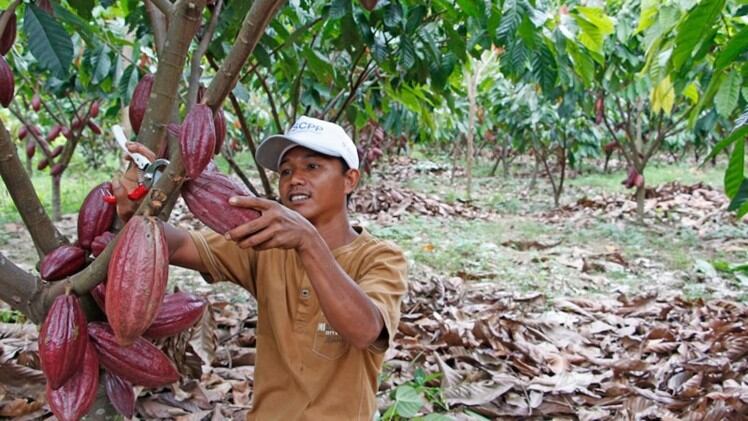The Cocoa Association of Asia (CAA) says it remains cautiously upbeat about the industry despite latest Asia region data on cocoa grindings showing a 10% drop against the same Q3 period in 2019.
With latest global cocoa grind figures (which are an indication of how many beans are turned into chocolate bars and other products) registering a fall of approximately -6% due to the interruption to supply chains caused by the COVID-19 pandemic, the CAA says it has confidence in the measures taken by actors across the Asian cocoa value chain to respond to the difficult circumstances of 2020.
With this year’s CAA conference in Singapore postponed until November 2021, the leading Cocoa Association in Asia for both cocoa and chocolate companies, held its first successful online forum: Will Cocoa Demand Grind To A Halt, to discuss the recent data and outlook for cocoa demand in Asia during the global COVID-19 pandemic.
Marc Donaldson, Executive Director of the Cocoa Association of Asia, told ConfectioneryNews: “There are many other industries that have suffered tremendously from this disease and my first thoughts were that it would have a lot of impact on West Africa, and maybe also South America, as you saw early on the early problems that Ecuador had with COVID, which is a big supplier to the world now.”
Donaldson has been in his current role for 18 months and has over 30 years’ experience (22 in Asia) in the sourcing, development and marketing of cocoa and chocolate products.
The reality is sustainability is about somebody having enough income in their lives to live a balanced and sustainable life and to keep their kids in food and go to school -- Marc Donaldson, Executive Director of the Cocoa Association of Asia
Home baking
With the upsurge in home baking caused by the pandemic, essential ingredients like cocoa powder will always be in demand, which bodes well in general for the sector. A possible downside is what happens post COVID?
“I think if people realise they can bake at home and to me, they're going to continue to … the first thing the industry should do is focus on convenience. A lot of these ready-to-go convenient mixes and bases just need to be repurposed a little .. maybe in packaging, smaller pack sizes and clear labelling and instructions.”
Donaldson says he thinks that with weather conditions such as an expected strong El Niño bringing wetter conditions to West Africa, the industry can expect a good cocoa crop in the 2020-21 season. The introduction of the Living Income Differential (LID) in Ghana and Cote d’Ivoire could lead to an over-supply as farmers will be encouraged to grow more cocoa.
Asia currently imports 80% of the cocoa beans it processes, mostly from West Africa and also increasingly from Latin America. In its webinar, the CAA says supply chains could also be hit by an unsettled global environment with upcoming elections in the USA and West Africa, and the Brexit transition in Europe at the end of 2020.
After several years of contraction, cocoa growing is rising again in the region. Ten years ago, Indonesia used to grow approximately 600,000 tons of cocoa.
“I think it's generally accepted that the current crop is going to be about 220 to 230,000 tons. So that's a long way down,” says Donaldson.
“Asia itself is grinding about a million tons, which is 20% of the world's crop, which is unbelievable. In the past five years it's been growing at an average of 16% a year, which compared to the rest of the world, is absolutely amazing. In general, over that period, America has been pretty flat and Europe has been plus 3 to 4%.”
Domestic consumption
Although current Asia demand per capita for cocoa and chocolate products is low compared with Europe or the USA, the region’s young and increasingly growing middle class population means domestic consumption presents significant growth opportunities for the future.
The CAA predicts Asia is set to become the second biggest cocoa powder market in the world, with expectations that within five years the Asia Pacific region could become the number two in the world for the demand for cocoa and chocolate – moving ahead of the United States.
“We've got over a billion people in China. We've got over a billion people in India. It's a massive market,” says Donaldson.
The CAA has over 30 members, including big suppliers like Cargill, Olam, Barry Callebaut and Touton, and is set to implement its own sustainability guidelines in the next 12 months, developing a programme with the UN on education for children working in Asia’s cocoa sector.
Sustainability
“The reality is sustainability is about somebody having enough income in their lives to live a balanced and sustainable life and to keep their kids in food and go to school,” says Donaldson.
“And if we, as an industry, can't manage that it means in the future we won't have any cocoa farmers because the average age of cocoa farmers in the world is getting older and older – the same with all smallholders. It's now 58, 10 years ago it was 55 and the average lifespan of a cocoa farmer the in the Ivory Coast, is, I think, 63 or 64.
“So now we have to focus on the people who aren't going to be the cocoa industry in the future and that has to be the younger generation. If they do not see that there is a way forward then they won't have any attraction to joining the industry.
"But I think the reality is that if we've got, for instance, 230,000 tons of cocoa coming out of Indonesia, then surely the target - and I know this is what the large companies and our members on the ground are trying to do - to teach enough farmers who show a real interest to grow, firstly more cocoa on the land they’ve got, which is the biggest challenge.
“It's an easy one if you understand how to do it, but actually it's hard work and having achieved that then the challenge is to grow more quality cocoa," he says.
Donaldson says in his 22 years involved in the cocoa industry in Asia, he has never witnessed anything he would consider bad practice or an abusive labour environment. He puts this down to cultural differences with the farmers in West Africa and better infrastructure in cocoa growing communities such as roads, buildings and sanitation.
In Indonesia, growing cocoa for many farmers is an option, whereas in areas of Africa, people don’t have that option because there are fewer alternatives and therefore more problems with unsustainable practices in their supply chains.
With a strong Asian market fuelling demand at home and from the main producers in West Africa and Latin America who will be looking to increase production in the future, Asia could indeed hold the key to the recovery in the cocoa sector.


